

Calatrava Wins 2005 AIA Gold Medal
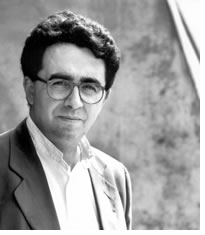 Architect-engineer-artist
Santiago Calatrava, FAIA, whose soaring structural poetry in bridges
and buildings has garnered international acclaim, was selected December
2 by the AIA Board of Directors to receive the 2005 AIA Gold Medal. The
highest honor the Institute confers to an individual, the Gold Medal
recognizes an individual whose significant body of work has had a lasting
influence on the theory and practice of architecture. Calatrava will
be presented with the medal at the 2005 American Architectural Foundation Accent
on Architecture Gala,
February 11, 2005, at the National Building Museum in Washington, D.C.
Architect-engineer-artist
Santiago Calatrava, FAIA, whose soaring structural poetry in bridges
and buildings has garnered international acclaim, was selected December
2 by the AIA Board of Directors to receive the 2005 AIA Gold Medal. The
highest honor the Institute confers to an individual, the Gold Medal
recognizes an individual whose significant body of work has had a lasting
influence on the theory and practice of architecture. Calatrava will
be presented with the medal at the 2005 American Architectural Foundation Accent
on Architecture Gala,
February 11, 2005, at the National Building Museum in Washington, D.C.
“Wonderful, thank you! I feel very honored,” Calatrava said, upon learning the news of his award via a telephone call to Zurich from AIA President Eugene C. Hopkins, FAIA, and the rest of the AIA Board. “I will try to stay at this level of honor for the rest of my career to honor you with my work.”
 Elegance of simplicity
Elegance of simplicity
The elemental and lyrical forms of Calatrava’s architecture, known
and loved across the globe, most recently have manifested in his cathedral-like
design for the World Trade Center’s transportation hub, the $2
billion open-air design linking the ferries, trains, commuter trains,
and subway lines that converge at the
World Trade Center site. Also this year, millions enjoyed
the harmony created at the 2004 Summer Olympic Games in Athens thanks
to Calatrava’s
master plan, as well as his
spectacular designs for the Olympic Stadium, the Agora, and the Nation’s
Wall.
Among Calatrava’s other most notable recent works are: the expansion of the Milwaukee Art Museum (2001), his first building in the U.S.; Sondica Airport, Bilbao (2000); James Joyce Bridge, Dublin (2003); and the Auditorio de Tenerife, Santa Cruz, Canary Islands (2003). Nearing completion are the Petach Tikvah Bridge, Tel Aviv; Quarto Ponte sul Grand Canale, Venice; the Turtle Bay Bridge, Redding, Calif.; and the Palacio de las Artes, the last building for Valencia’s City of Arts and Sciences. Calatrava’s firm also is currently designing Atlanta’s Symphony Center.
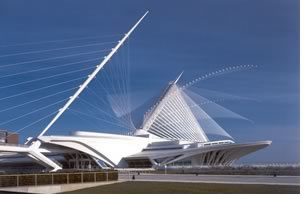 In
nominating him for the award, 2004 Committee Chair J. Windom Kimsey,
FAIA, and 2002 AIA Vice President Edward J. Kodet, FAIA—on behalf
of the AIA Committee on Design—wrote, “Santiago Calatrava
exemplifies sculptural expression and engineering through architecture
. . . Calatrava’s
work is like music: well orchestrated. It is architecture that delights
and finds new meaning each time it is experienced.” The committee
also noted, “Santiago Calatrava’s work seeks out the essence
of architecture. His architecture expands the vision and expresses the
energy of the human spirit, captivating the imagination and delighting
us in the wonders of what sculptural form and dynamic structure can accomplish.
Santiago Calatrava defines the reason for the Gold Medal. His vision
elevates the human spirit through the creation of environments in which
we live, play, and work.”
In
nominating him for the award, 2004 Committee Chair J. Windom Kimsey,
FAIA, and 2002 AIA Vice President Edward J. Kodet, FAIA—on behalf
of the AIA Committee on Design—wrote, “Santiago Calatrava
exemplifies sculptural expression and engineering through architecture
. . . Calatrava’s
work is like music: well orchestrated. It is architecture that delights
and finds new meaning each time it is experienced.” The committee
also noted, “Santiago Calatrava’s work seeks out the essence
of architecture. His architecture expands the vision and expresses the
energy of the human spirit, captivating the imagination and delighting
us in the wonders of what sculptural form and dynamic structure can accomplish.
Santiago Calatrava defines the reason for the Gold Medal. His vision
elevates the human spirit through the creation of environments in which
we live, play, and work.”
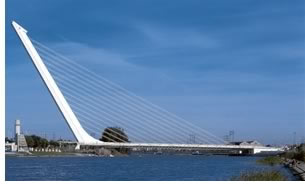 Building bridges
Building bridges
A native of Valencia, Spain, Calatrava, whose heritage extends back to
a medieval order of knights, began his formal instruction in the arts
at the age of eight. He was a teenager when Spain’s dictatorship
relaxed its travel restrictions, allowing him to study in Paris and
Switzerland as an exchange student. He earned his degree in architecture
from the Escuela Tecnica Superior de Arquitectura in Valencia and a
PhD in engineering from the Federal Institute of Technology (ETH) in
Zurich. Calatrava established his first office in Zurich and soon after
gained acclaim as a bridge designer, beginning with the commission
of the Bach de Roda Bridge for the 1984 Olympic Games in Barcelona.
Among his other feats of bridge engineering and beauty are the Alamillo
Bridge for the World’s Fair in Seville (1992), the Campo Volantin
Footbridge in Bilbao (1997), and the Alameda Bridge and subway station
in Valencia (1995).
 Establishment of the firm’s second
office in Paris in 1989 coincided with the design of the Lyon Airport
Station, which was completed in 1994. Concurrently the firm worked
on the acclaimed BCE Place Hall in Toronto. A third office in Valencia
followed in 1991 with work on the City of Arts and Sciences, a very
large cultural complex, which continues to this day.
Establishment of the firm’s second
office in Paris in 1989 coincided with the design of the Lyon Airport
Station, which was completed in 1994. Concurrently the firm worked
on the acclaimed BCE Place Hall in Toronto. A third office in Valencia
followed in 1991 with work on the City of Arts and Sciences, a very
large cultural complex, which continues to this day.
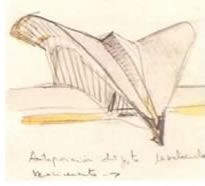 A resonance with the public and designers alike
A resonance with the public and designers alike
Among his myriad awards Calatrava counts the Gold Medal of the Institute
of Structural Engineers, London; the City of Toronto Urban Design Award,
Toronto; the Gold Medal for Merit in the Fine Arts, Ministry of Culture,
Spain; Time magazine’s “Best of 2001” designation
for the Milwaukee Art Museum expansion; the Sir Misha Black Medal,
Royal College of Art, London; the Leonardo da Vinci Medal, Florence;
the Gold Medal of Architecture of L’Academie d’Architecture,
Paris; the European Steel Design Award for the University of Zurich
roof, Lucerne, Switzerland; the Silver Beam Award of the Swedish Institute
of Steel Construction, Gotherburg, Sweden; the Illuminating Design
Award of Merit of the Illuminating Engineering Society of North America,
New York; and 13 honorary doctorates.
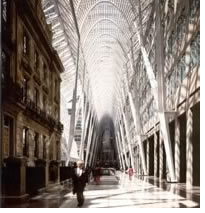 Calatrava
has captured the hearts and imagination of the public and his clients
as well as those of designers and engineers around the globe. Joseph
J. Seymour, executive director of the Port Authority of New York and
New Jersey, summed up the impact of Calatrava’s
work when writing about the World Trade Center Transportation Hub,
for which the Port Authority is the client. “In addition to being
an inspiration in this country and around the world, Mr. Calatrava’s
transportation facility will serve thousands of commuter and tourists
each day, Seymour pointed out. “ . . . Mr.
Calatrava captivated the New York – New Jersey region when he unveiled
a soaring, spectacular design concept for the transportation hub, which
will be one of the centerpieces for the redeveloped World Trade Center
site. It is my firm belief that Mr. Calatrava’s 150-foot, glass-and-steel
winged building will one day serve as an inspiring architectural icon
for New York City, rivaling some of the city’s more famous transportation
facilities, including Grand Central Station.”
Calatrava
has captured the hearts and imagination of the public and his clients
as well as those of designers and engineers around the globe. Joseph
J. Seymour, executive director of the Port Authority of New York and
New Jersey, summed up the impact of Calatrava’s
work when writing about the World Trade Center Transportation Hub,
for which the Port Authority is the client. “In addition to being
an inspiration in this country and around the world, Mr. Calatrava’s
transportation facility will serve thousands of commuter and tourists
each day, Seymour pointed out. “ . . . Mr.
Calatrava captivated the New York – New Jersey region when he unveiled
a soaring, spectacular design concept for the transportation hub, which
will be one of the centerpieces for the redeveloped World Trade Center
site. It is my firm belief that Mr. Calatrava’s 150-foot, glass-and-steel
winged building will one day serve as an inspiring architectural icon
for New York City, rivaling some of the city’s more famous transportation
facilities, including Grand Central Station.”
Copyright 2004 The American Institute of Architects.
All rights reserved. Home Page ![]()
![]()
 |
||
| Visit Santiago
Calatrava online. Photo © Rosselli Paolo Photo © Helfenstein Heindrich Photo © Schuh/Berg Palladium Photodesign Photo © Alan Karchmer
|
||